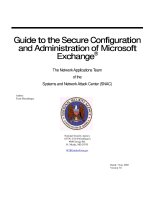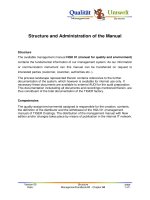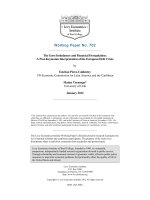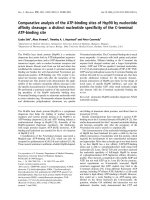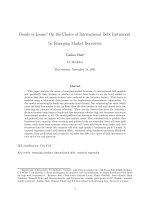The administration of debt relief by the international financial institutions a legal reconstruction of the HIPC initiative
Bạn đang xem bản rút gọn của tài liệu. Xem và tải ngay bản đầy đủ của tài liệu tại đây (2.86 MB, 369 trang )
Max-Planck-Institut für ausländisches
öffentliches Recht und Völkerrecht
Beiträge zum ausländischen
öffentlichen Recht und Völkerrecht
Begründet von Viktor Bruns
Herausgegeben von
Armin von Bogdandy · Rüdiger Wolfrum
Band 202
Leonie F. Guder
The Administration of Debt
Relief by the International
Financial Institutions
A Legal Reconstruction of the HIPC Initiative
ISBN 978-3-540-88608-2
Springer Berlin · Heidelberg · New York
e-ISBN 978-3-540-88609-9
DOI 10.1007/978-3-540-88609-9
Beiträge zum ausländischen öffentlichen Recht und Völkerrecht ISSN 0172-4770
Bibliografische Information der Deutschen Nationalbibliothek
Die Deutsche Nationalbibliothek verzeichnet diese Publikation in der Deutschen Nationalbibliografie; detaillierte bibliografische Daten sind im Internet über abrufbar.
© by Max-Planck-Gesellschaft zur Förderung der Wissenschaften e.V., to be exercised by Max-PlanckInstitut für ausländisches öffentliches Recht und Völkerrecht, Heidelberg 2009
Dieses Werk ist urheberrechtlich geschützt. Die dadurch begründeten Rechte, insbesondere die der Übersetzung, des Nachdrucks, des Vortrags, der Entnahme von Abbildungen und Tabellen, der Funksendung, der
Mikroverfilmung oder der Vervielfältigung auf anderen Wegen und der Speicherung in Datenverarbeitungsanlagen, bleiben, auch bei nur auszugsweiser Verwertung, vorbehalten. Eine Vervielfältigung dieses Werkes
oder von Teilen dieses Werkes ist auch im Einzelfall nur in den Grenzen der gesetzlichen Bestimmungen
des Urheberrechtsgesetzes der Bundesrepublik Deutschland vom 9. September 1965 in der jeweils geltenden Fassung zulässig. Sie ist grundsätzlich vergütungspflichtig. Zuwiderhandlungen unterliegen den
Strafbestimmungen des Urheberrechtsgesetzes.
Die Wiedergabe von Gebrauchsnamen, Handelsnamen, Warenbezeichnungen usw. in diesem Werk berechtigt auch ohne besondere Kennzeichnung nicht zu der Annahme, dass solche Namen im Sinne der Warenzeichen- und Markenschutz-Gesetzgebung als frei zu betrachten wären und daher von jedermann benutzt
werden dürften.
Einbandgestaltung: WMXDesign GmbH, Heidelberg
Gedruckt auf säurefreiem Papier
987654321
springer.de
Acknowledgements
This study is the outcome of my PhD research which I conducted at the
Max Planck Institute for Comparative Public and International Law in
Heidelberg, Germany and which was accepted by the Law Faculty of
the Johann Wolfgang Goethe-Universität in Frankfurt am Main in December 2007.
I would like to thank my thesis advisor, Prof. Dr. Armin von Bogdandy,
for his support of this research and the opportunity to publish it as part
of the Max Planck Institute’s Beiträge zum ausländischen öffentlichen
Recht und Völkerrecht. Likewise, I would like to thank Prof. Dr. Stefan
Kadelbach for writing the second opinion and my colleagues from the
“Dienstagsrunde” at the Max Planck Institute for their remarks and
helpful suggestions in the various phases of this work.
I also owe special thanks to the German Executive Director’s Office at
the World Bank for hosting and supporting me in my research on
HIPC during a two month research period at the World Bank in 2006.
This stay was financially supported by a research scholarship of the
DAAD, for which I am likewise grateful.
Most notably, I would like to thank my family and friends for their
continuous support and encouragement.
Leonie F. Guder
Abstract
This study addresses the mechanisms of debt relief for Heavily Indebted Poor Countries jointly coordinated by the International Monetary Fund and the World Bank under the HIPC Initiative.
Forty countries, most of them in Sub-Sahara Africa, have participated
in the Initiative and pursued the Initiative’s reform agenda in exchange
for debt relief. Through the last decade since its inception, the HIPC
program has not only become the linchpin for debt relief, addressing
about one fourth of the international community and 725 million people in Sub-Sahara Africa, but has also created a new operational field of
World Bank and IMF activity. With regard to its funding and finances
as well as its institutional practices, this new operational field deviates
significantly from the traditional areas of IMF and World Bank engagement.
This study describes the content of the HIPC program and classifies it
as a legally non-binding instrument under public international law. A
case study on Ghana further illustrates the reform process under the
HIPC Initiative, sheds light on its implementation practice and provides some insight into the collaboration between the IMF, the World
Bank and the respective HIPC member states.
As the study reveals, the Initiative’s soft-law character contrasts with its
capacity to effectively integrate and coordinate other multilateral and
bilateral creditors under the HIPC relief scheme and to prescribe to
HIPC debtors a detailed reform program. It is hence by means of a
global governance perspective and global administrative law theory that
the study demonstrates that design and sequencing of the HIPC Initiative create a regulatory space of coordinated creditor and debtor interaction in which the IMF and the World Bank assume a central position
in the provision and coordination of debt relief.
Thus, for the specific category of heavily indebted and very poor member states, the IMF and World Bank succeeded to establish a sovereign
state insolvency mechanism. To this day, however, the long-term economic effectiveness of this mechanism remains disputed.
Table of Content
Introduction ............................................................................................ 1
1. Objectives and Plan of the Study......................................................... 1
2. Literature Review.................................................................................. 9
3. Structure............................................................................................... 20
Part I. Multilateral Debt Relief for Heavily
Indebted Poor Countries ................................................................... 23
A. The Heavily Indebted Poor Countries Initiative
(HIPC) ..................................................................................................... 26
1. Concessional Assistance to Low-Income Countries ....................... 26
2. The HIPC Framework ....................................................................... 30
2.1. The Heavily Indebted Poor Country Initiative of 1996 ........ 33
2.2. The Cologne G-8 Summit of 1999 and HIPC II.................... 39
2.3. Eligibility and Implementation under the
Enhanced HIPC Framework ................................................... 43
3. What kind of debt is addressed by HIPC? ....................................... 48
4. HIPC Funding and Finances ............................................................. 50
4.1. The PRGF-HIPC Trust of the IMF ........................................ 51
4.2. The World Bank HIPC Trust Fund ........................................ 57
4.3. The IDA Debt Reduction Facility........................................... 60
4.4. HIPC Financing through Multilateral Creditors ................... 61
4.5. Conclusion: Trust Fund Financing.......................................... 62
5. HIPC Proceedings .............................................................................. 63
B. Debt Relief under the G-8: The Multilateral
Debt Relief Initiative (MDRI) .......................................................... 67
1. MDRI as Operational Successor of HIPC........................................ 69
2. Subsequent Changes in Lending Policies .......................................... 74
C. Case Study: The Contemporary History of
Debt Relief in Ghana........................................................................... 77
1. Ghana’s History with Economic Aid ................................................ 80
2. Ghana’s Reform Process under HIPC .............................................. 86
Table of Content
X
2.1.
3.
4.
5.
6.
Implementation of the HIPC Framework.............................. 89
2.1.1. Preliminary Documents ............................................... 97
2.1.2. Ghana Poverty Reduction Strategy............................. 98
2.1.3. Decision Point Document ......................................... 102
2.1.4. Ghana’s Completion Point ........................................ 104
2.2. Donor Coordination under the Multi Donor Budgetary
Support (MDBS) ..................................................................... 106
2.3. Civil Society Participation...................................................... 108
Ghana beyond HIPC Completion .................................................. 111
Perception by the National and International Public .................... 114
Model Character and Comparability of Ghana’s HIPC Process
with other HIPC Countries ............................................................. 118
5.1. Prescribed Policy Reforms ..................................................... 119
5.2. PRSP Process........................................................................... 120
5.3. Implementation of HIPC Reforms ....................................... 124
5.4. Board Approval....................................................................... 126
Findings.............................................................................................. 128
Part II. Doctrinal Reconstruction of HIPC in a
Public International Law Perspective .......................................... 131
1. The Legal Quality of the HIPC Program under the Law of
IMF and IDA .................................................................................... 136
1.1. Decision-Making by the Board of Governors
and the Executive Directors ................................................... 137
1.2. Decision-Making by the Development Committee............. 140
1.3. Obligations of IMF and IDA Member States under
the HIPC Program.................................................................. 141
1.4. Legal Effects of Board Decisions on the Domestic
Law of Member States ............................................................ 145
1.5. Legal Effects of Decisions Interpreting the Articles of
Agreement ............................................................................... 146
1.6. Conclusion............................................................................... 148
2. Legal Relationship Between the HIPC Debtor and the
International Financial Institutions ................................................. 150
2.1. Contractual Obligations......................................................... 150
2.1.1. Letter of Intent under the Fund’s PRGF
Arrangement ............................................................... 150
2.1.2. Relief Disbursements under the Trust Funds........... 154
2.1.3. HIPC (Relevant) Documents .................................... 155
2.2. Obligations under the IMF and World Bank’s
Institutional Law..................................................................... 157
Table of Content
XI
2.2.1. The IMF’s Doctrine of Uniform Treatment ............. 158
2.2.2. Equality of Treatment under the Bank Articles ....... 160
2.3. International Obligations of the Fund and the Bank
under the ICESCR and an Evolving International
Development Agenda ............................................................. 161
2.4. Conclusion............................................................................... 171
3. Legal Relationship Between the HIPC Debtor and its Bi- und
Multilateral Creditors ....................................................................... 172
3.1. Paris Club Commitments....................................................... 172
3.1.1. Practices and Proceedings for Paris Club Debt
Reschedulings.............................................................. 173
3.1.2. Legal Effects of Paris Club Reschedulings under
the HIPC Program ..................................................... 176
3.2. G-8 Commitments.................................................................. 179
4. Legal Relationship between the HIPC Debtor and non-Paris
Club and Commercial Creditors ..................................................... 180
4.1. The London Club ................................................................... 180
4.2. HIPC Creditor Litigation ...................................................... 182
4.2.1. Claims by Non-Paris Club Members ....................... 182
4.2.2. Commercial Creditor Litigation ............................... 185
4.2.3. Booker plc v. Co-operative Republic of Guyana..... 187
4.2.4. Pari Passu Clause ........................................................ 188
5. Conclusion: “Beyond the Radar Screen of International Law” .... 190
Part III. Multilateral Debt Relief Under HIPC –
Global Governance Perspectives ................................................... 195
1. Global Governance ........................................................................... 196
2. A Global Administrative Law Perspective on HIPC..................... 205
2.1. Descriptive Account: HIPC as a Global Administrative
Law Phenomenon ................................................................... 207
2.2. Institutional Framework for Administrating Debt Relief ... 211
2.3. Substantive Requirements ...................................................... 212
2.4. Regulatory Procedure............................................................. 215
2.5. Means of Regulation ............................................................... 217
2.6. Means of Enforcement............................................................ 219
2.6.1. The Official Incentive Structure of the HIPC
Program ....................................................................... 220
2.6.2. Joint Bank-Fund Conditionality ............................... 220
2.6.3. The Role of Supplementary Financiers..................... 221
2.6.4. The Signalling Effect of IMF and World Bank
Participation ................................................................ 222
XII
Table of Content
2.6.5. Interacting Creditor Fora........................................... 224
2.6.6. Naming and Shaming ................................................. 225
2.7. Assessment............................................................................... 225
3. Findings: HIPC as an Instrument of Global Governance ............. 229
3.1. Specifications of the HIPC Program’s Soft Law Nature ..... 230
3.2. Global Governance Phenomena and the
International Legal Order ...................................................... 233
Part IV. Issues of Legitimacy .......................................................... 237
1. Legitimacy: An Iridescent Concept................................................. 239
2. Charter Based Legitimacy of the HIPC Program .......................... 244
2.1. The Doctrine of ultra vires..................................................... 245
2.2. Legal Analysis in the Light of the Bank and the
Fund’s Mandate and Mission ................................................. 247
2.3. Guiding Principles and Interpretative Methodology........... 251
2.4. Findings ................................................................................... 259
3. Issues of Sovereign Equality and Self-Determination.................... 260
3.1. Institutional Ownership ......................................................... 262
3.2. Conditionality ......................................................................... 263
3.3. Findings ................................................................................... 264
4. Procedural Accountability ............................................................... 266
4.1. Systemic and Sound Rulemaking........................................... 267
4.1.1. Policy Creation ........................................................... 267
4.1.2. The Decision Maker ................................................... 268
4.1.3. Decision-Making Standards and Procedures............ 269
4.2. Transparency, Public Participation and the Right
to Information ......................................................................... 271
4.2.1. Institutional Transparency ......................................... 271
4.2.2. Access to Documents ................................................. 273
4.2.3. Involvement of Stakeholders and Civil Society
Actors .......................................................................... 273
4.2.4. Complaint Procedures................................................ 274
4.3. Power Sharing and Institutional Checks and Balances ........ 275
4.3.1. Divided Authority and Delegation ........................... 275
4.3.2. Review of Board Decisions........................................ 277
4.4. Findings ................................................................................... 278
5. Relief Achievements and Effectiveness of the HIPC Initiative..... 279
6. Findings and Recommendations...................................................... 283
Table of Content
XIII
Part V. Conclusions ......................................................................... 289
1. HIPC as Role Model for an International Insolvency
Procedure for States? ........................................................................ 291
2. “Soft Law versus Hard Law” – Soft Legal Regulation as Means
for Institutional Adaptation and Development .............................. 299
3. Legal Research on IMF and World Bank ........................................ 303
Bibliography ........................................................................................ 309
Index ....................................................................................................... 351
List of Abbreviations
AB
Appellate Body
ADB
Asian Development Bank
AfDB
African Development Bank
AfDF
African Development Fund
APRM
African Peer Review Mechanism
BADEA
Arab Bank for Economic Development in Africa
BCEAO
Central Bank of West African States
BOAD
West African Development Bank
(Banque Ouest Africaine de Développement)
BP
Bank Procedure
CABEI
Central American Bank for Economic Integration
CAF
Corporación Andina de Fomento
CARICOM
Caribbean Community
CAS
Country Assistance Strategy
CDF
Comprehensive Development Framework
CESCR
Committee on Economic, Social and Cultural Rights
CMCF
CARICOM Multilateral Clearing Facility
CPIA
Country Performance and Institutional Assessment
DSA
Debt Sustainability Analysis
DSF
Debt Sustainability Framework
EADB
East African Development Bank
ECA
Economic Commission for Africa
ECHR
European Court of Human Rights
ECOWAS
Fund for Cooperation Compensation & Development
of the Economic Community of West African States
EFA
Education for All
EIB
European Investment Bank
ERP
Economic Recovery Program
ESAF
Enhanced Structural Adjustment Facility
List of Abbreviations
XVI
EU
European Union
FONPLATA
Financial Fund for the Development of the River Plate
Basin
FSLC
Financial Sector Liaison Committee
FTI
Fast Track Initiative
GAL
Global Administrative Law
GDP
Gross Domestic Product
GNPC
Ghana National Petroleum Corporation
GPRS
Ghana Poverty Reduction Strategy
GRA
General Resource Account of the IMF
HIPC
Heavily Indebted Poor Countries
IADB
Inter-American Development Bank
IBRD
International Bank for Reconstruction and Development
ICESCR
International Covenant on Economic, Social and Cultural Rights
ICJ
International Court of Justice
ICSID
International Court for the Settlement of Investment
Disputes
IDA
International Development Association
IEG
Independent Evaluation Group
IFAD
International Fund for Agricultural Development
IFC
International Finance Corporation
ILO
International Labour Organization
IMF
International Monetary Fund
IMFC
International Monetary and Financial Committee
I-PRSP
Interim Poverty Reduction Strategy Paper
ISDB
Islamic Development Bank
JIC
Joint Implementation Committee
JSA
Joint Staff Assessment
LAP
Land Administration Project
LOI
Letter of Intent
MDBs
Multilateral Development Banks
MDBS
Multi-Donor Budgetary Support
List of Abbreviations
XVII
MDG
Millennium Development Goals
MDRI
Multilateral Debt Reduction Initiative
MEFP
Memorandum of Economic and Financial Policies
MEPRC
Ministry of Economic Planning and Regional Cooperation
MIGA
Multilateral Investment Guarantee Agency
MOFEP
Ministry of Finance and Economic Planning
NDC
National Democratic Congress
NDF
Nordic Development Fund
NDPC
National Development and Planning Commission
NEPAD
New Partnership for Africa’s Development
NIB
Nordic Investment Bank
NIRP
National Institutional Renewal Programme
NPP
New Patriotic Party
NPV
Net Present Value
OAPEC
Organization of Arab Petroleum Exporting Countries
OD
Operational Directive
ODA
Official Development Assistance
OECD
Organisation for Economic Cooperation and Development
OED
Operations Evaluation Department (now IEG)
OP
Operational Procedure
OPEC
Organization of the Petroleum Exporting Countries
PAF
Poverty Action Fund
PBA
Performance Based Allocation
PIN
Public Information Notice
PREM
Poverty Reduction and Economic Management Network of the World Bank
PRGF
Poverty Reduction Growth Facility
PRMED
Economic Policy and Debt Department of the World
Bank
PRSC
Poverty Reduction Support Credit
PRSP
Poverty Reduction Strategy Paper
PSIA
Poverty and Social Impact Analysis
List of Abbreviations
XVIII
SCA
Special Contingent Account
SDA
Special Disbursement Account
SDR
Special Drawing Rights
SDRM
Sovereign Debt Restructuring Mechanism
TEC
Treaty Establishing the European Community
UK
United Kingdom
UN
United Nations
UNCTAD
United Nations Conference on Trade and Development
UNDP
United Nations Development Programme
UNESCO
United Nations Educational, Scientific and Cultural
Organization
US
United States
WHO
World Health Organization
WIDER
World Institute for Development Economic Research
(United Nations University)
WTO
World Trade Organization
Introduction
1. Objectives and Plan of the Study
This study will focus on debt relief under the Highly Indebted Poor
Countries Initiative (HIPC) and explore its legal basis. The Initiative
was first launched in 1996 and modified three years later in order to expand eligibility for the program. The 1999 Initiative, in its modified and
enhanced version, will be the subject of this investigation.
HIPC debt relief is jointly conducted by IMF and World Bank. It targets low-income countries and ascertains the extent of debt relief to the
amount necessary to achieve debt sustainability. Compared to earlier
debt relief efforts, debt relief under the HIPC program is unique because it also includes multilateral debts, i.e., debt owed to multilateral
financial institutions.
The program is novel not only for the kind of debt relieved under the
program, but also for the program’s reform focus on poverty reduction
and domestic policies. The program thus represents a shift in the paradigms which used to form the basis of development support by the International Financial Institutions. Development programs used to adhere to the paradigm of market liberalization and deregulation under
the Washington Consensus of the early 1990s.1 In the late 1990s, development aid and policy reforms focused on the significance of institutions for the development process as vital means for achieving development were discovered. The World Development Report 19972 can be
seen as a first step in establishing the programmatic basis for the HIPC
and the therein embedded poverty reduction strategy. The international
community followed this new approach (also called “Post-Washington
Consensus”), committing itself to the Millennium Development Goals
1
Priewe and Herr, The Macroeconomics of Development and Poverty Reduction, Strategies Beyond the Washington Consensus, 2005.
2
World Bank, World Development Report 1997. The State in a Changing
World, 1997.
Introduction
2
in 20003 and pledging increased donor assistance at the Monterrey Conference in 2002.4
Debt relief under the HIPC program constitutes the latest development
effort of IMF and World Bank. The program conditionalities build
upon World Bank reform programs of the 1990s. However, its design
and its interaction and coordination with other multilateral institutions
constitute a new area of World Bank and IMF activities which is worth
distinguishing from the development policy lending and investment
lending areas of the Bank. Due to the program’s monetary and constitutional significance, it also calls for a legal analysis.
This study intends to shed light on the legal relationship between the
IMF and the World Bank and the debt relief recipients from a public international law perspective. The purpose is to legally reconstruct and
formalize the interaction between the International Financial Institutions and the HIPC debtor countries in order to demonstrate the existence of legal procedures in a process that is usually labelled as political
and voluntary. The study explicitly refers to a “doctrinal reconstruction” instead of using other possible terminology, such as “assessment”
or “analysis”, because it seeks to re-construct the legal relationships established in the course of HIPC participation between the International
Financial Institutions, the HIPC country and the other actors participating in the implementation of HIPC debt-relief. The term debt relief
is thereby understood as a restructuring of debt that contains an element of forgiveness or reduction, thus relieving the overall debt burden
of a country.
To lay the foundation for the doctrinal reconstruction, the reconstruction will be preceded by a description of the HIPC program, its reformatory content and its application in the case study of Ghana. Moreover, in order to link this study to the wider development context and
to further the understanding of the HIPC Initiative altogether, references to underlying economic theories and political considerations will
be made in the course of investigation, when appropriate.
The International Financial Institutions, respectively the IMF and the
World Bank Group with its affiliates (IBRD, IDA, IFC, MIGA,
3
In September 2000, 147 heads of state and government and 189 nations
committed themselves to eight programmatic goals tackling development in the
UN General Assembly Resolution of September 18, 2000 (A/RES/55/2).
4
Monterrey Consensus, A/CONF.198/11, < />Monterrey-Consensus-excerpts-aconf198_11.pdf> (last visited 18/05/08).
Introduction
3
ICSID), have assumed a major role in the coordination and accomplishment of development aid and development financing. In the era of
decolonialization, early development aid by international donors focused on infrastructure projects and community development. Most of
the financial aid and technical cooperation was offered to the (former)
colonies of the respective donors. Then in the 1960s and with the rise of
nation states in Africa, aid agencies were increasingly influenced by
modernization theory and a focus on growth.5 At this time, the International Development Association was also established, and interest free
loans were now available to IDA eligible countries. World Bank lending
through IBRD had previously taken place exclusively under market
terms.
By the early 1970s, an increase in technical support projects had caused
a growing technical dependence of developing countries on their donors, particularly with respect to engineering and agricultural skills. In
development studies, this was identified as the so-called dependency
theory.
During the oil crises, under President McNamara, the World Bank’s6 attention shifted to poverty reduction predicated on a basic needs assessment. Consequently, household surveys were included in the poverty
analysis, educational lending increased, and – for the first time – women
were included in the development discussions, as targets for support
and as donor organizations active in the field (UN-Conference on
Women, 1975). Health care also became a new sector of development,
brought to the attention of the international community by the International Conference on Primary Health Care in 1978. Subsequently, at the
end of the 1970s, the World Bank started health lending. Apart from the
5
For modernization theorists, development involved synergies between
democratization and economic growth.
6
The term “World Bank” or Bank refers to IBRD and IDA. Staff, organizational structures and their respective Articles of Agreement are almost identical. Both institutions have slightly different voting structures, but since IDA
membership is confined to IBRD member governments, the effects are minimal.
They usually act and are perceived as one entity, but they concentrate on different areas of activity. Whereas both IBRD and IDA promote economic development, increase productivity and raise the standards of living of their member
states, IDA provides development assistance and development aid to the less
well off member countries, “thereby furthering the development objectives of
the International Bank for Reconstruction and Development and supplementing its activities” (Art. I IDA Articles of Agreement). IBRD for its part provides assistance and enhanced access to capital.
Introduction
4
rise of new policy sectors, development aid furthermore attracted new
participants in the 1970s. Following the break up of the Bretton Woods
System in 1973, the G-7 (today G-8) forum was established in 1975 in
order to promote better coordination among the leading industrialist
nations.7
In 1980, the Brandt Commission,8 by recognizing the structural reasons
for poverty, prompted a move away from project support to balanceof-payments support and to attaching policy reforms to the transfer of
funds. This was the era of IMF and World Bank’s structural adjustment
lending.9 None the less, the aided countries accumulated more and
more debts. Mexico threatened to default10 in 1982 and during the mid
1980s, especially in Latin America, the debt crises deepened.11 Consequently, the first efforts to relieve developing countries of their debts
were born. Under the Brady Plan,12 commercial banks were unsuccess7
On the policy cooperation between the IMF and the Group of Seven see
Boughton, Silent Revolution. The International Monetary Fund, 1979-1989,
2001, at 186.
8
Commission, also known under the name “Independent Commission on
International Development Issues,” founded in 1977 and chaired by Willy
Brandt. The Brandt Commission’s two reports “North-South” (1980) and
“Common Crisis: North-South Cooperation for World Recovery” (1983) addressed international issues of food and agricultural development, aid, energy,
trade as well as international monetary and financial reform. World Bank President McNamara first introduced the idea of promoting dialogue between the
North and South through the establishment of an international commission of
politicians and economists.
9
Mosley, Harrigan and Toye, Aid and Power. The World Bank and Policybased Lending. Volume I. Analysis and Policy Proposals, 1991. See also Peet,
Unholy Trinity. The IMF, World Bank and WTO, 2003, at 120. Also on the
changing programmatic of structural adjustment, Siebold, Armutsbekämpfung
oder Strukturanpassung? Kontinuität und Wandel der Weltbank-Programmatik
für Afrika, in: Messner and Nuscheler (Eds.), Weltkonferenzen und Weltberichte. Ein Wegweiser durch die internationale Diskussion, 1996, pp. 37-60.
10
A default is any failure by a debtor to meet its contractual obligations.
The main event of default is to miss a scheduled payment of principal or interest
of a loan.
11
Muns (Ed.), Adjustment, Conditionality, and International Financing,
1984.
12
The Brady Plan was created in 1988/89 but it did not amount to a full
fledged debt relief program like the HIPC Initiative. In contrast to HIPC, debts
were not cancelled. Instead, the Brady Plan offered new debt managing options
Introduction
5
fully encouraged to write off some of their debts with funds provided
by the International Financial Institutions. Aid agencies nevertheless
continued to support countries with weak governance. Motivated by
cold war geo-strategic considerations, development aid remained for
many countries often political in nature.
The emerging debt crisis of the 1980s caused the IMF to develop new
debt reducing guidelines in 1989 and to provide support for commercial
bank debt and debt service reduction operations. The IMF had already
established the Enhanced Structural Adjustment Facility (ESAF) in
1987, through which it provided low-interest loans to poor countries.
In the 1990s, the neoclassicism embodied in the “Washington Consensus” and the policy conditions inherent to the IMF and World Bank’s
structural adjustment programs were increasingly questioned and criticized by civil society and likeminded scholars. The result was a new
emphasis on democracy and good governance combined with a call for
participatory planning and for the appraisal of development projects. 13
Thus, at the beginning of the 1990s, development aid drastically
changed its shape and content for a second time. Whereas the first dramatic change was caused by the overcoming of colonial relations, the
second drastic change in the nature and content of development aid
took place at the end of the cold war (pre and post Washington Consensus period). After the end of the cold war, development programs
became more comprehensive in their approach, calling for the implementation of good governance, the rule of law and democracy. Parsed
into their a-political components, these reforms have been disguised as
anti-corruption measures, the promotion of accountability and transparency or the implementation of the rule of law. Each of these components has been introduced into the reform catalogues of the IMF and
World Bank after economic approval of their significance for economic
through access to specially assigned Fund resources and debt rescheduling.
Boughton, Silent Revolution. The International Monetary Fund, 1979-1989, at
491.
13
As example World Bank, Reforming Public Institutions and Strengthening Governance, 2003. On governance reform: Schlemmer-Schulte, Die Rolle
der Internationalen Finanzorganisationen im Nord-Süd-Konflikt, in: Meng,
Magnus, Epiney, Stoll, Cottier and Schlemmer-Schulte (Eds.), Das Internationale Recht im Nord-Süd Verhältnis – Berichte der Deutschen Gesellschaft für
Völkerrecht, 2005, pp. 149-215.
Introduction
6
growth. Thus, governance and also its absence, expressed in phenomena
such as corruption, were recognized as development issues.14
Most quoted in this respect is the 1989 World Bank Report on SubSahara Africa.15 It marks the beginning of the debate on good governance within the World Bank. The same holds true for the concept of social capital, as deployed by the Bank’s social development experts,
which serves to address the territory of technical [and not political, sic!]
intervention. Social capital – as the term already indicates – is rooted in
economic considerations16 and refers to the social ties and membership
of particular communities that make resources, advantages and opportunities available to individuals.17 Taken up by World Bank economists,18 the concept of social capital had been made serviceable for
World Bank reform programs. Along these lines, poverty reduction also
has been taken up as a development issue suited for World Bank and
IMF action.
From a legal point of view, it is important to note that due to the
emerging comprehensiveness of development aid, the 1990s also mark
the beginning of discussions on a legal entitlement to a democratic and
14
See Williams and Young, Governance, the World Bank and Liberal Theory, 42 Political Studies (1994) 84-100.
15
World Bank, Sub-Sahara Africa. From Crisis to Sustainable Growth. A
Long-term Perspective Study, 1989.
16
Knack and Keefer, Does Social Capital Have Economic Payoff? A CrossCountry Investigation, 112 Quarterly Journal of Economics (1997) 1251-1288.
17
As a concept, social capital was defined independently by Pierre Bourdieu
and by James Coleman in the 1980s. Bourdieu, The Forms of Capital, in:
Richardson (Ed.), Handbook of Theory and Research for the Sociology of
Education, 1986. Coleman, Social Capital in the Creation of Human Capital, 94
(supplement) American Journal of Sociology (1988) s 95-s 120.The basic difference between these two definitions revolves around the underlying reason for
the development of social processes. In more recent years, the ideas of Coleman
have been further developed by Robert Putman, whose definition became most
prominent.
18
Publications on social capital raise, for example, the issues of poverty reduction and conflict resolution: Colletta and Cullen, Violent Conflict and the
Transformation of Social Capital: Lessons from Cambodia, Rwanda, Guatemala, and Somalia, 2000. Narayan, Voices of the Poor: Poverty and Social Capital in Tanzania, 1997. More generally, Serageldin and Dasgupta, Social Capital:
A Multifaced Perspective, 2001.
Introduction
7
good government on the one hand,19 and the corresponding (old) problem of interference in the domestic affairs of a sovereign state. By including reforms of domestic institutions or of the domestic legal order
in the respective development frameworks, the exposure of developing
countries to financial aid conditionalities and requirements gained a
new quality. The impact of the development approach on the sovereignty and self-determination of the recipient countries continues to be
discussed today.
Despite the massive influx of loans and (later) grants by the international donor community, some countries, particularly in conflict-ridden
Africa, were not able to make progress in their development efforts or
in their loan repayments. Instead, those countries became increasingly
caught up in the debt servicing trap, soliciting new loans in order to reschedule and repay existing debts. In the 1990s, the international financial community recognized that the debt situation for a number of lowincome countries had become unbearable, preventing any prospect for
economic development. For these countries, even the comprehensive
use of existing means of debt reduction through private or governmental channels (London Club and Paris Club) was insufficient to attain
sustainable and manageable debt levels without additional external support. Reacting to these economic grievances, the International Financial
Institutions jointly endorsed a debt relief program for highly indebted
poor countries (HIPC), coordinating the efforts of the international
community and, for the first time, participating themselves in it. It was
launched in September 1996.
Debt relief under the HIPC Initiative and the newly created poverty
reduction strategies replaced the earlier structural adjustment programs
in 1996.20 The corresponding Poverty Reduction Strategy Papers
(PRSPs), which constitute a central part of the Initiative, serve as a national strategy framework for reducing poverty. With the Poverty Re19
Interestingly, the debate originated from the affected, who demanded the
inclusion of requirements for democratic participation and good government in
the international agenda for development. Ezetah, The Right to Democracy, 22
Brooklyn Journal of International Law (1997) 495-534. Udombana, Articulating the Right to Democratic Governance in Africa, 24 Michigan Journal of International Law (2003) 1209-1287. Ibegbu, Right to Democracy in International
Law, 2003.
20
See Cling, Razafindrakoto and Roubaud, New Poverty Reduction Strategies: Old Wine in New Bottles?, in: Tungodden, Stern and Kolstad (Eds.), Toward Pro-Poor Policies. Aid, Institutions, and Globalization, 2004, pp. 111-131.
8
Introduction
duction Strategies, three new objectives for approaching development
and poverty reduction were announced: ownership, empowerment and
accountability. All three became the buzzwords for the future reform.
As salient as they sound, they stand for the down-to-earth claim of focusing on the involvement and participation of stakeholders and civil
society in the preparation and implementation phases of the PRSP.
In late 1999, the IMF established the Poverty Reduction and Growth
Facility (PRGF) to make the objectives of poverty reduction and
growth more central to the lending operations in its poorest member
countries. In the same year, following a comprehensive review, debt relief under the HIPC Initiative was modified and programmatically
linked to poverty reduction. Subsequently, as part of the HIPC program, debt-relief became conditional on the formulation of a Poverty
Reduction Strategy. Apart from this programmatic change, a number of
other modifications were approved to provide faster, deeper and
broader debt relief to an extended circle of eligible countries.
Both the current approaches towards debt relief and poverty reduction
are the result of a long tradition of development programs promoted by
the World Bank and IMF. However, the relationship between developing countries and the International Financial Institutions is only one
aspect of the field of international development efforts. To describe all
development initiatives and relief efforts currently undertaken by the
international community, creditor institutions or non-governmental actors would clearly exceed the limits of this study. Instead, this research
is exclusively devoted to a legal analysis of HIPC and the legal relationship between the participating countries in the Enhanced HIPC Initiative and the International Financial Institutions. At its core is a legal reconstruction of the internal institutional processes of HIPC eligibility
and appraisal as well as a legal analysis of the creditor and debtor relationship from a public international law perspective. In this context, the
wider international development debate, including the UN Development Goals and the International Human Rights Covenants, will be
considered.
Debt relief under HIPC is based on the voluntary participation of
highly indebted member states in a joint program of the International
Monetary Fund and the World Bank. In order to be eligible for debt relief at the end of the program, a HIPC country undertakes structural,
i.e. institutional, and economic reforms.
The disclosure policies of the IMF and World Bank and the lack of information on the internal political process of borrowing countries have
always prevented an analysis of concessional credit lending under the
Introduction
9
general Poverty Reduction and Growth Facility (PRGF), i.e. the IMF’s
low-interest lending facility for low-income countries.21 For the first
time, the HIPC Initiative – as a special part of PRGF with stricter eligibility criteria – offers the potential for legally reconstructing and evaluating PRGF-supported programs due to a different disclosure policy (in
comparison to that of PRGF) and a different incentive structure for the
respective country. The disclosure requirements of HIPC commit all
participating countries to subscribe to a complete disclosure of the relevant documents. These documents will be presented to the reader in
Part I of this study and be the subject of closer scrutiny in the case
study of Ghana. Subsequently, Part II and III will provide a legal reconstruction and an assessment of the formal and informal implementation
mechanisms inherent to the HIPC reform process.
Where public international law proves to be inadequate in describing
the normative environment surrounding HIPC debt relief and in assessing the existing relationship between the International Financial Institutions and the debt relief recipients, alternative theories of political science and the newly emerging field of a “global administrative law” will
be employed to assess the existing commitments and power relations.
Moreover, given the scale of IMF and World Bank’s activities under the
HIPC Initiative and its comprehensive program design, the HIPC Initiative’s economic and financially motivated involvement in the sovereign domain of national politics and the national legal order poses questions of fundamental importance. As “issues of legality,” questions of
legitimacy and sovereign self-determination will likewise be addressed
in Part IV of this study.
It is the wish of the author to extend the legal perspective of her research and to simultaneously allow room for economic and political
considerations. This aim is also reflected by the references made in the
footnotes and the following overview of the relevant literature.
2. Literature Review
The importance of development aid in its bilateral, international or
multilateral forms has generated extensive research, particularly in the
political and social sciences and among economists. With regard to the
21
On the Bank’s disclosure policy regarding Board documents, Shihata,
The World Bank Legal Papers, 2000, at 725.
